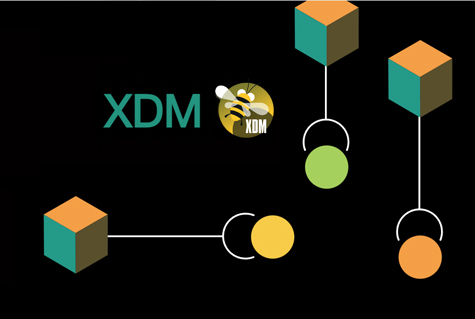To optimize the user interface (UI) for XDM, UBS Hainer recently conducted a comprehensive usability survey with several of its customers. Ideally, the UI is designed in such a way that users can effectively utilize and control the application’s features to complete their tasks efficiently. The interviews provided valuable insights into user experiences and identified potential areas for improvement.
The UI team at UBS Hainer enhances user experience
In general, the UI for UBS Hainer’s applications is a crucial factor, as it enables direct interaction between users and the software. An effective UI facilitates the use of features, thereby enhancing customers’ daily work and productivity.
At UBS Hainer, a dedicated UI team focuses solely on designing and testing the user interfaces of software products like XDM. When a new feature is developed by the core team—which is responsible for the fundamental components of the software—the UI experts work to optimize it for user interaction.
This includes the continuous improvement of the visual and functional aspects of the UI to enhance the user experience and, consequently, customer satisfaction. To ensure this, a survey was conducted among several UBS customers.
Customer survey to optimize innovation
The customer survey was designed to gain insight into how users interact with the UI and what they value most. The overarching goal was to generate a comprehensive product understanding of XDM and improve the application’s features and attributes for users. Ultimately, the survey sought to obtain valuable information on where developers should focus their efforts and which areas should be prioritized.
“What excites a developer may not necessarily improve the user experience,” explains project lead and software developer Katharina Schenk. “And what seems obvious to a developer might leave users with a lot of questions.”
It is therefore crucial to understand and know what is important to the customer and how they interact with XDM’s features and interfaces daily. This can best be achieved through direct surveys.
“To gather such feedback for our decision-making, we created a usability questionnaire for XDM and gauged customer interest in participating,” says Katharina. Initially, customers answered an online questionnaire. The results were then analyzed by the UI team and served as a basis for follow-up personal interviews. Here, additional questions were asked, suggestions were noted, and specific topics were explored in depth.
Systematic coverage
In the questionnaire, users first evaluated and commented on various XDM components. This was followed by a value analysis of the XDM features and the concrete usage of the software and tools. Finally, the work processes were simulated in direct interviews. “It was very exciting for us,” says Katharina, “because customers showed us live how they use XDM in their daily tasks and which areas they work with most.” This provided insight into the specific ways tasks are accomplished with XDM and the role the UI plays in this process.
One key finding from the survey was that users within the same company have different requirements for XDM. “Depending on whether they are responsible for task creation, execution monitoring, or failure analysis, their focus areas differ,” explains UI team software developer Alicia Hill. “This affects which XDM features are used and which remain relatively unknown, even though they might be helpful.”
The survey included questions about the frequency of active usage and the self-explanatory, intuitive usability of the features. Efficiency was also examined: Can users achieve their work goals with minimal clicks? Are the views and functionalities of the components easy to remember, intuitive, and predictable? How does XDM handle input errors? Are these errors detected and visualized early? And generally, how satisfied are users with the interface and functionalities?
But that wasn’t all: “Together with the user we conducted a detailed analysis of individual views and UI areas,” Katharina explains. “This included topics such as the display of lists, filters, tags, jump marks, quick views, and the various areas of the dashboard. We asked users which information was particularly helpful and what improvements they would like to see.”
Alicia noted that the navigation and use of lists were particularly noteworthy. “Knowing which paths are preferred and which could be improved provides guidance for further development.”
The user’s perspective helps address a fundamental dilemma for UI experts: “On one hand, we want to display ‘as much information as possible’ in each view, and on the other, we aim to provide ’clear and easily accessible information.’ The challenge lies in finding a balance,” explains Alicia.
Implementing the results
The survey provided valuable insights that can only be gained through direct dialogue with users. “Some points were resolved simply through our explanations,” says Katharina. “In some cases, customers were unaware of certain capabilities. We also noted everything that could be implemented quickly and addressed these issues promptly and efficiently.”
Apart from insights into the UI and numerous suggestions for improvements, direct conversations also allowed the UI experts to resolve some user questions immediately. “Some users had only been working with a limited part of XDM, missing out on features that they found very helpful once we explained them,” Alicia notes. “For instance, users who were unaware of tags were delighted when we demonstrated their benefits in the specific use case.”
Larger projects and requests were presented to the team. Customer priorities helped determine which features should be addressed first. Together, the team brainstormed the best ways to implement these changes.
For example, Quick Views allow users to save frequently used filters and sortings as specific buttons, avoiding the need to input them manually each time. Some customers provided feedback that they would like to use this functionality more often but found it insufficiently stable. Such feedback prompts a re-evaluation of the UI team’s planned tasks and re-prioritization.
Overall, very positive feedback
To establish an initial baseline, the comprehensive survey covered the entire application. This involved significant effort in both developing and conducting the survey, but it was well worth it, enabling the UI team to enhance customer benefits.
The respondents reacted very positively to the usability dialogue. Many customers appreciated the direct contact with developers. “Once this baseline analysis is complete, we will conduct more targeted surveys for improvements in specific areas or the development of new features,” Katharina explains. “We are extremely grateful for our customers’ constructive collaboration. Future surveys will be less extensive as a result.”


